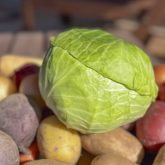Lettuce, particularly romaine and iceberg, is in short supply and high demand across North America. You may see empty lettuce shelves or prices so high you simply walk by.
Except for a few local growers, most lettuce greens come from the southern U.S. or Mexico. But drought and severe weather caused many lettuce and other produce crops to suffer in the U.S. growing areas.
Romaine lettuce had the added pressure of a virus that destroyed California’s crop. That left a big gap in the supply of greens and other fruits and vegetables. Restaurants in particular are scrambling to find enough greens to make salads and top burgers and sandwiches. Some have even stopped serving salads temporarily.
Read Also

Manitoba Ag Days plans star-studded speaker lineup
Dragons’ Den panellist Arlene Dickinson among speaker series highlight for 2026 Manitoba Ag Days in Brandon, alongside slate of agriculture experts.
For consumers, finding our favourite greens at an affordable price has become a real challenge.
Some food experts predict lettuce shortages and price increases could last well into January. Others are hoping that by December, the next crop to ripen in Yuma, Arizona, and northern Mexico will fill demand.
Is this a temporary glitch or is this a sign of the challenges growers and food supply chains will continue to face in the future?
[RELATED] OCN’s Smart Farm is a source of physical and mental health
At home, does this mean no more salads? While some family members might be happy at the idea, we’re not ready to ditch salads yet. Even without the greens, salads offer delicious and nutritious ways to ensure we get our daily servings of vegetables and fruits (four to six for kids and seven to 10 for adults).
The more ways we can get those nutrient rich, colourful fruits and veggies, the better. We just need to think differently about how we make winter salads.
The first option is to swap regular lettuce greens with other greens like spinach, kale, mesclun mix, arugula, Swiss chard or even bok choy. A good tip for using these hardy greens is to chop them into small pieces or ribbons so they’re less intimidating. So far, these greens are available at relatively affordable prices. But, as restaurants and consumers switch, their prices may soon go up as well.
The second option is to ditch the greens altogether and do what our grandparents did. Use whatever seasonal ingredients are available. Traditionally on the Prairies, fresh greens were not available during the winter months at all. Instead, our predecessors used cabbage, beets, carrots, squash, potatoes and apples to make salads. Instead of Caesar or tossed salad, they had beet and apple salad, coleslaw, bean salad or carrot salad.
[RELATED] From Peak to obsolete
Using vegetables and fruits as the base for salads is similar to making any other salad. The only added consideration is cutting or cooking hardy vegetables to ensure they’re easy to chew.
For example, raw carrots are best shredded, beets and squash should be cubed and roasted or boiled, cauliflower and broccoli should be briefly steamed or cut into small bite-sized pieces. Frozen, canned or pickled vegetables also make great additions to these salads. Some can be used as is, while others benefit from cooking briefly, depending on preference.
If you want to turn winter salads from a side dish to a full meal, here are some tips to make them stand out.
- Combine several types of fruits and vegetables to get different colours and textures.
- Add ingredients that hit all the taste buds – sweet, salty, sour, bitter and umami.
- Use or make your favourite salad dressing. One of the key benefits of winter salads is that they won’t wilt. You can add the dressing and keep them in the fridge for three to four days.
- Finish with toppings that add more interest, flavour, colour and texture. For example, croutons, toasted nuts or seeds add crunch while dried cranberries or pomegranate seeds add sweetness, herbs add colour and grated cheese adds salty, creamy, umami flavour.
- Add whole grains like quinoa, bulgur or wheatberries for long lasting energy.
- Add chicken, fish, beef, pork, eggs or tofu for added protein to keep people feeling satisfied long after they leave the table.
















